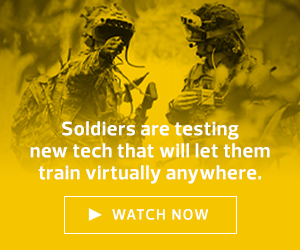How Mixed Reality Training Helps Army Soldiers
Using the IVAS platform, soldiers no longer need to go to a mission training complex to get training and learn to do common tasks, says Lt. Col. Carlos J. Kavetsky, capability developer at STE CFT. “Now, he does that at the point of need with the actual equipment he uses to fight with,” he says. “He gets to do that, augment the actual environment with holograms that are intelligent, that will react to what the soldier is doing, seek cover, fight back and engage and interact with the soldier in that simulation.”
The Army has been iterating on the IVAS platform in design sprint cycles with a wide range of Army components, including Program Executive Office Soldier, the SL CFT and STE CFT, with soldier input at each decision point.
The IVAS platform has a body-borne compute pack, conformal wearable battery, squad radio and integrated thermal and low-light sensors that provide the close combat force a single platform on which to fight, rehearse and train.
Additionally, IVAS integrates next-generation, 24/7 situational awareness tools and high-resolution simulations to deliver a single platform that improves soldier sensing, decision-making, target acquisition and target engagement. All of those capabilities make it easier to train soldiers in an agile and dynamic way.
“It really captures the effects of actual combat,” says Staff Sgt. Travis Hodge of the Army’s 10th Mountain Division, based at Fort Drum, N.Y. “I can take soldiers from any formation and get them up to speed with what the squad’s good at.”
The technology also allows soldiers to review training simulations after the fact. “You can see it, play back in third-person,” says Sgt. Loren Collins of the 10th Mountain Division. “When you get to walk through in real time, looking down on the virtual projection of what happened, you get to see things that maybe you didn’t see while you’re on the ground as a leader.”
Collins adds that the training platform enables soldiers to interact with “a dynamic, intelligent opponent that will give you feedback and will actually engage you. It definitely adds another dimension of realism.”
In November, the Army finished its third of four major testing and demonstration events of IVAS at Fort Pickett, Va., with participants from the 82nd Airborne Division and a contingent of Marines taking part in company-size training events using the first militarized prototype of the IVAS. “Events included land navigation, live fire, mission planning, rapid target acquisition, trench clearing, after action review using augmented reality, and more,” the Army says in a blog post.













